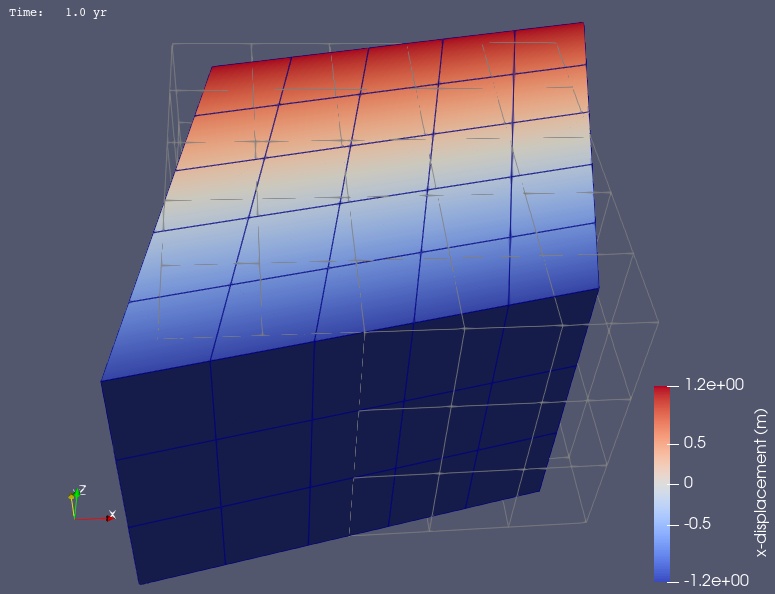Step 3: Shear Displacement and Tractions#
In Step 3 we replace the Dirichlet (displacement) boundary conditions on the +y and -y boundaries with equivalent Neumann (traction) boundary conditions. In order to maintain symmetry and prevent rigid body motion, we constrain both the x and y displacements on the +x and -x boundaries. The solution matches that in Step 2. Fig. 43 shows the boundary conditions on the domain.
Fig. 43 Boundary conditions for shear deformation. We constrain the x and y displacements on the +x and -x boundaries. We apply tangential (shear) tractions on the +y and -y boundaries.#
Features
Tetrahedral cells
pylith.meshio.MeshIOPetsc
pylith.problems.TimeDependent
pylith.materials.Elasticity
pylith.materials.IsotropicLinearElasticity
spatialdata.spatialdb.UniformDB
pylith.meshio.OutputSolnBoundary
pylith.meshio.DataWriterHDF5
Static simulation
ILU preconditioner
pylith.bc.DirichletTimeDependent
pylith.bc.NeumannTimeDependent
spatialdata.spatialdb.SimpleDB
spatialdata.spatialdb.ZeroDB
Simulation parameters#
The parameters specific to this example are in step03_sheardisptract.cfg.
The primary change from Step 2 is the use of Neumann (traction) boundary conditions in pylith.problem.bc.
The tractions are uniform on each of the two boundaries, so we use a UniformDB.
In PyLith the direction of the tangential tractions in 2D is defined by the cross product of the +z direction and the outward normal on the boundary.
On the +y boundary a positive tangential traction is in the -x direction, and on the -y boundary a positive tangential traction is in the +x direction.
We want tractions in the opposite direction as shown by the arrows in Fig. 43, so we apply negative tangential tractions.
$ pylith step03_sheardisptract.cfg
# The output should look something like the following.
>> /software/unix/py39-venv/pylith-debug/lib/python3.9/site-packages/pylith/meshio/MeshIOObj.py:44:read
-- meshiopetsc(info)
-- Reading finite-element mesh
>> /src/cig/pylith/libsrc/pylith/meshio/MeshIO.cc:94:void pylith::meshio::MeshIO::read(topology::Mesh *)
-- meshiopetsc(info)
-- Component 'reader': Domain bounding box:
(-6000, 6000)
(-6000, 6000)
(-9000, 0)
# -- many lines omitted --
>> /software/baagaard/py38-venv/pylith-debug/lib/python3.8/site-packages/pylith/problems/TimeDependent.py:139:run
-- timedependent(info)
-- Solving problem.
0 TS dt 0.01 time 0.
0 SNES Function norm 2.854246293576e-02
Linear solve converged due to CONVERGED_ATOL iterations 1
1 SNES Function norm 2.511862662012e-17
Nonlinear solve converged due to CONVERGED_FNORM_ABS iterations 1
1 TS dt 0.01 time 0.01
>> /software/baagaard/py38-venv/pylith-debug/lib/python3.8/site-packages/pylith/problems/Problem.py:201:finalize
-- timedependent(info)
-- Finalizing problem.
The output written to the terminal is nearly identical to what we saw for Step 2. The linear solve did require only 7 iteration to converge.
Visualizing the results#
In Fig. 44 we use ParaView to visualize the x displacement field using the viz/plot_dispwarp.py Python script.
As in Step 2 we override the default name of the simulation file with the name of the current simulation before running the viz/plot_dispwarp.py Python script.
>>> SIM = "step03_sheardisptract"

Fig. 44 Solution for Step 3. The colors of the shaded surface indicate the magnitude of the x displacement, and the deformation is exaggerated by a factor of 1000. The undeformed configuration is show by the gray wireframe. The solution matches the one from Step 2.#
